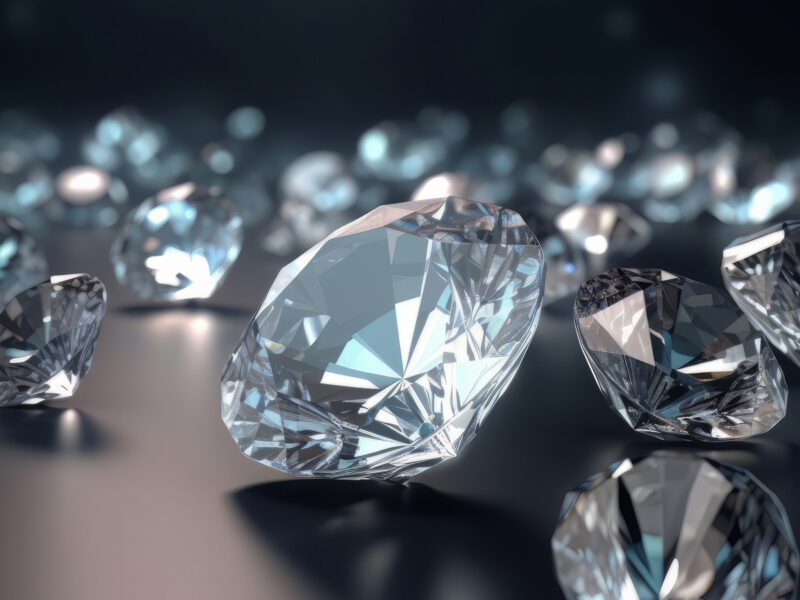
When it comes to selecting the perfect diamond, understanding diamond cuts is essential for making an informed choice. The cut of a diamond is often considered the most important factor in determining its overall beauty and brilliance. While carat weight, color, and clarity are important, it’s the diamond cut that dictates how well a diamond reflects light. In this article, we’ll explore the various diamond cuts, their characteristics, and why they matter.
Table of Contents
What Are Diamond Cuts?
Understanding diamond cuts begins with recognizing that the cut refers to how well the diamond has been shaped and polished. It affects the diamond’s proportions, symmetry, and finish, ultimately influencing how light interacts with the stone. A well-executed diamond cut enhances the stone’s brilliance and fire, creating that coveted sparkle. On the other hand, a poorly cut diamond may appear dull and lifeless, regardless of its color or clarity. Thus, the quality of the diamond cut plays a crucial role in its overall appeal.
The Different Types of Diamond Cuts
When it comes to understanding diamond cuts, several popular styles stand out, each offering unique characteristics. Here are some of the most common diamond cuts:
1. Round Cut
The round cut is the most popular diamond cut, renowned for its exceptional brilliance and sparkle. With 58 facets, this cut maximizes light reflection, making it a top choice for engagement rings. The round cut’s timeless elegance ensures that it remains a favorite among consumers seeking a classic look. For many, understanding diamond cuts would be incomplete without recognizing the round cut’s enduring popularity.
2. Princess Cut
The princess cut is known for its contemporary appeal and is the second most popular diamond cut. This cut features a square or rectangular shape with pointed corners and numerous facets that create remarkable brilliance. The princess cut is perfect for those who desire a modern look while still benefiting from a diamond’s sparkle. Understanding diamond cuts means appreciating how the princess cut offers a balance between traditional and contemporary styles.
3. Cushion Cut
The cushion cut, sometimes referred to as the “pillow cut,” has a soft, rounded appearance with large facets that enhance its brilliance. This cut has gained popularity for its vintage charm and romantic appeal. Cushion-cut diamonds can vary in shape, making them versatile for various jewelry styles. Understanding diamond cuts would not be complete without recognizing the cushion cut’s unique blend of history and modernity.
4. Emerald Cut
The emerald cut is distinguished by its rectangular shape and step-cut facets, which create a hall-of-mirrors effect. This cut emphasizes clarity and color rather than brilliance, making it ideal for man made diamonds with fewer inclusions. The emerald cut’s elegant lines and sophisticated look appeal to those who appreciate understated luxury. Understanding diamond cuts includes recognizing how the emerald cut offers a different kind of beauty that showcases a diamond’s clarity.
5. Asscher Cut
Similar to the emerald cut, the Asscher cut features a square shape and step-cut facets, but with a more pronounced depth. This vintage-inspired cut offers a unique sparkle and is often chosen for its Art Deco aesthetic. Understanding diamond cuts means acknowledging the Asscher cut’s return to popularity, as more consumers seek distinctive and classic styles for their jewelry.
6. Oval Cut
The oval cut is an elongated version of the round cut, providing a unique appearance while maintaining similar brilliance. This cut can create the illusion of a larger carat weight and is flattering on many finger shapes. The oval cut is an excellent choice for those seeking a modern twist on traditional styles. Understanding diamond cuts involves appreciating how the oval cut combines elegance with versatility.
7. Pear Cut
The pear cut, also known as the teardrop cut, combines the best features of the round and marquise cuts. It has a rounded end and a pointed tip, creating a unique and elongated shape. This cut is popular for earrings and pendants, as it offers a distinct silhouette. Understanding diamond cuts includes recognizing the pear cut’s ability to add a touch of elegance and individuality to any jewelry piece.
8. Marquise Cut
The marquise cut features an elongated shape with pointed ends, resembling a boat. This cut maximizes carat weight, making it appear larger than other shapes of the same carat weight. The marquise cut is often chosen for its dramatic flair and unique appearance. Understanding diamond cuts would not be complete without acknowledging the marquise cut’s bold and eye-catching characteristics.
The Importance of Diamond Cut Quality
Beyond the shape of the diamond, understanding diamond cuts also involves recognizing the quality of the cut itself. The quality is graded based on several factors, including:
- Proportions: The angles and measurements of the diamond that affect light performance.
- Symmetry: The precision of the diamond’s facets and their alignment.
- Finish: The quality of the diamond’s surface and polish.
A well-cut diamond will exhibit excellent proportions, symmetry, and finish, leading to enhanced brilliance and sparkle. In contrast, a poorly cut diamond may have an unfavorable appearance, even if it has excellent clarity and color. Understanding diamond cuts necessitates considering the quality of the cut to ensure that you select a stone that truly shines.
How to Choose the Right Diamond Cut for You
When choosing a diamond, understanding diamond cuts can help you find the perfect match for your style and preferences. Consider the following factors:
- Personal Style: Determine whether you prefer classic, modern, or vintage designs.
- Ring Setting: Some cuts work better with specific ring settings, so consider how the diamond will look in your chosen design.
- Budget: Certain cuts may be more affordable than others, depending on their popularity and demand.
By taking these factors into account, you can select a diamond cut that not only aligns with your aesthetic preferences but also fits your budget.
Conclusion
Understanding diamond cuts is essential for anyone looking to invest in a beautiful and meaningful piece of jewelry. The cut of a diamond significantly impacts its sparkle, brilliance, and overall appearance, making it one of the most important factors to consider. From the classic round cut to the unique marquise cut, each style offers its own charm and character. By gaining insight into the various diamond cuts and their qualities, you can make an informed decision and choose a diamond that truly reflects your style and values.







